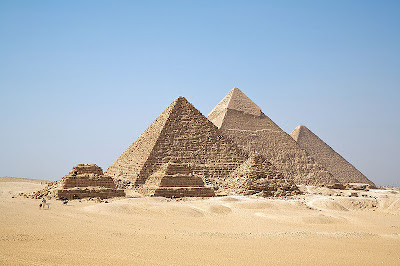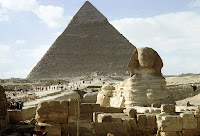The Giza Necropolis stands on the Giza Plateau, on the outskirts of Cairo, Egypt. This complex of ancient monuments includes the three pyramids known as the Great Pyramids, along with the massive sculpture known as the Great Sphinx. It is located some 8 km or 5 miles inland into the desert from the old town of Giza on the Nile, some 25 km 15 miles southwest of Cairo city centre. One of the monuments, the Great Pyramid of Giza, is the only remaining monument of the Seven Wonders of the Ancient World.
 The Great Pyramids consist of the Great Pyramid of Giza, the somewhat smaller Pyramid of Khafre a few hundred meters to the south-west, and the relatively modest-sized Pyramid of Menkaure a few hundred meters further south-west. The Great Sphinx lies on the east side of the complex, facing east. Current consensus among Egyptologists is that the head of the Great Sphinx is that of Khafre. Along with these major monuments are a number of smaller satellite edifices, known as queens pyramids, causeways and valley pyramids.
The Great Pyramids consist of the Great Pyramid of Giza, the somewhat smaller Pyramid of Khafre a few hundred meters to the south-west, and the relatively modest-sized Pyramid of Menkaure a few hundred meters further south-west. The Great Sphinx lies on the east side of the complex, facing east. Current consensus among Egyptologists is that the head of the Great Sphinx is that of Khafre. Along with these major monuments are a number of smaller satellite edifices, known as queens pyramids, causeways and valley pyramids.In the four major monuments, Menkaures Pyramid is seen today without any of its original polished limestone casing. Khafres Pyramid retains a prominent display of casing stones at its apex, while Khufus Pyramid maintains a more limited collection at its base. Khafres Pyramid appears larger than the adjacent. The most active phase of construction here was in the 23rd century BC. It was popularised in Hellenistic times when the Great Pyramid was listed by Antipater of Sidon as one of the Seven Wonders of the World. Today it is the only one of the ancient Wonders still in existence.
Pyramids of Giza were the tallest structures on the planet. Khufus pyramid originally rose 479 feet but reduced to 449 feet with the loss of its limestone casing. Khafre's Pyramid had stood 471 feet at its completion while Menkaure's Pyramid stands at a modest 218 feet. In 1300 AD the Great Pyramid was surpassed as the tallest structure in the world by England's Lincoln Cathedral. Due largely to 19th-century images, the Pyramids of Giza are generally thought of by foreigners as lying in a remote, desert location, even though they are located in what is now part of the most populous city in Africa . The ancient sites in the Memphis area, including those at Giza, together with those at Saqqara, Dahshur, Abu Ruwaysh, and Abusir, were collectively declared a World Heritage Site in 1979.
Researchers have long been impressed with the precision with which the pyramids of this complex were created. The base of the Great Pyramid forms a nearly perfect square, with only a 19-cm or 7.50-in difference between its longest and shortest sides, out of a total length of about 230 m or 756 ft. The Great Pyramid raised 146.7 m or 481.4 ft nearly 50 stories high. Researchers estimate that 2.3 million blocks were used to build the Great Pyramid, with an average weight of about 2.5 metric tons per block. The largest block weighs as much as 15 metric tons.
It is not known how they were made but there have been varying theories regarding the construction techniques. Most construction theories are based on the idea that the pyramids were built by moving huge stones from a quarry and dragging and lifting them into place. The disagreements center on the method by which the stones were conveyed and placed and how possible the method was. A recent though unpopular theory proposes that the building blocks were manufactured in-place from a kind of limestone concrete.
The work of quarrying, moving, setting, and sculpting the huge amount of stone used to build the pyramids might have been accomplished by several thousand skilled workers, unskilled laborers and supporting workers. Bakers, carpenters, water carriers, and others were also needed for the project. Along with the methods utilized to construct the pyramids, there is also wide speculation regarding the exact number of workers needed for a building project of this magnitude. When Greek historian Herodotus visited Giza in 450 BC he was told by Egyptian priests that the Great Pyramid had taken 400,000 men 20 years to build, working in three-month shifts 100,000 men at a time.


In 1990, tombs belonging to the pyramid workers were discovered alongside the pyramids with an additional burial site found nearby in 2009. Evidence from the tombs indicates that a workforce of 10,000 laborers working in three month shifts took around 30 years to build a pyramid. Most of the workers appear to have been from poor families. Farms supplied the laborers with 21 cattle and 23 sheep daily. Specialists such as architects, masons, metalworkers and carpenters, were permanently employed by the king to fill positions that required the most skill.
The Pyramids of Giza and other were constructed to house the remains of the deceased Pharaohs who ruled over ancient Egypt. A portion of the Pharaoh's spirit called his ka was believed to remain with his corpse. Proper care of the remains was necessary in order for the former Pharaoh to perform his new duties as king of the dead. The pyramid not only served as a tomb for the Pharaoh but also as storage for the various items he would need in the afterlife. The people of Ancient Egypt believed that death on Earth was the start of a journey to the next world. The embalmed body of the King was entombed underneath or within the pyramid to protect it and allow his transformation and ascension to the afterlife.
Post Title
→Great Pyramids or Giza Necropolis
Post URL
→http://guidice-galleries.blogspot.com/2010/02/great-pyramids-or-giza-necropolis.html
Visit guidice galleries for Daily Updated Wedding Dresses Collection








